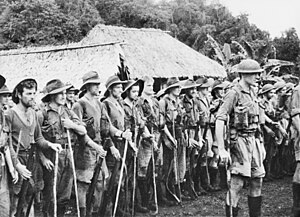
Back حملة طريق كوكودا Arabic Кокодска операция Bulgarian Kokoda-Track-Kampagne German Kampanjo de la Kokoda Vojo Esperanto Campaña del Sendero de Kokoda Spanish لشکرکشی مسیر کوکودا Persian Kokodantien taistelut Finnish Campagne de la piste Kokoda French המערכה על שביל קוקודה HE Kokoda ösvényi csata Hungarian
| Kokoda Track campaign | |||||||
|---|---|---|---|---|---|---|---|
| Part of the New Guinea Campaign of the Pacific Theater (World War II) | |||||||
 Soldiers of the Australian 39th Battalion in September 1942 | |||||||
| |||||||
| Belligerents | |||||||
|
|
| ||||||
| Commanders and leaders | |||||||
|
|
| ||||||
| Strength | |||||||
| 30,000[1] | 13,500[2] | ||||||
| Casualties and losses | |||||||
|
625 killed 1,055 wounded 4,000+ sick[3] |
≈2,050[4][notes 1] ~ 4,500 including sick[5][notes 2] | ||||||
The Kokoda Track campaign or Kokoda Trail campaign was part of the Pacific War of World War II. The campaign consisted of a series of battles fought between July and November 1942 in what was then the Australian Territory of Papua. It was primarily a land battle, between the Japanese South Seas Detachment under Major General Tomitarō Horii and Australian and Papuan land forces under command of New Guinea Force. The Japanese objective was to seize Port Moresby by an overland advance from the north coast, following the Kokoda Track over the mountains of the Owen Stanley Range, as part of a strategy to isolate Australia from the United States.
Japanese forces landed and established beachheads near Gona and Buna on 21 July 1942. Opposed by Maroubra Force, then consisting of four platoons of the 39th Battalion and elements of the Papuan Infantry Battalion, they quickly advanced and captured Kokoda and its strategically vital airfield on 29 July. Despite reinforcement, the Australian forces were continually pushed back. The veteran Second Australian Imperial Force (AIF) 21st Brigade narrowly avoided capture in the Battle of Mission Ridge – Brigade Hill from 6 to 8 September. In the Battle of Ioribaiwa from 13 to 16 September, the 25th Brigade under Brigadier Kenneth Eather fought the Japanese to a halt but ceded the field to the Japanese, withdrawing to Imita Ridge.
The Japanese advanced to within sight of Port Moresby but withdrew on 26 September. They had outrun their supply line and had been ordered to withdraw in consequence of reverses suffered at Guadalcanal. The Australian pursuit encountered strong opposition from well-prepared positions around Templeton's Crossing and Eora Village from 11 to 28 October. Following the unopposed recapture of Kokoda, a major battle was fought around Oivi and Gorari from 4 to 11 November, resulting in a victory for the Australians. By 16 November, two brigades of the Australian 7th Division had crossed the Kumusi River at Wairopi, and advanced on the Japanese beachheads in a joint Australian and United States operation. The Japanese forces at Buna–Gona held out until 22 January 1943.
Australian reinforcement was hampered by the logistical problems of supporting a force in isolated, mountainous, jungle terrain. There were few planes available for aerial resupply, and techniques for it were still primitive. Australian command considered that the Vickers machine gun and medium mortars were too heavy to carry and would be ineffective in the jungle terrain. Without artillery, mortars or medium machine guns, the Australians faced an opponent equipped with mountain guns and light howitzers that had been carried into the mountains and proved to be a decisive advantage. Australian forces were unprepared to conduct a campaign in the jungle environment of New Guinea. The lessons learned during the course of this campaign and the subsequent battle of Buna–Gona led to widespread changes in doctrine, training, equipment and structure, with a legacy that remains until the present day.
In consequence of the rapid Japanese advance and the perceived failure to quickly counterattack, a "crisis of command" resulted, in which manoeuvring by General Douglas MacArthur, Supreme Commander of Allied Forces in the South West Pacific Area, and General Sir Thomas Blamey, commander of Allied Land Forces, resulted in the sackings of three high-ranking Australian officers. The generalship of MacArthur and Blamey has been criticised for unreasonable and unrealistic perceptions of the terrain and conditions under which the campaign was fought—to the detriment of the troops committed to the fighting. The Kokoda Track campaign has been mythologised as Australia's Thermopylae and incorporated into the Anzac legend even though the premise of a vastly numerically superior enemy has since been shown to be incorrect.
- ^ McCarthy 1959, p. 234.
- ^ McCarthy 1959, p. 146.
- ^ McCarthy 1959, pp. 334–335.
- ^ Williams 2012, p. 235.
- ^ Coulthard-Clark 1998, p. 223.
- ^ James 2009, p. 72.
- ^ McAulay 1992b, p. 12.
- ^ a b Milner 1957, p. 144 and note 48.
Cite error: There are <ref group=notes> tags on this page, but the references will not show without a {{reflist|group=notes}} template (see the help page).